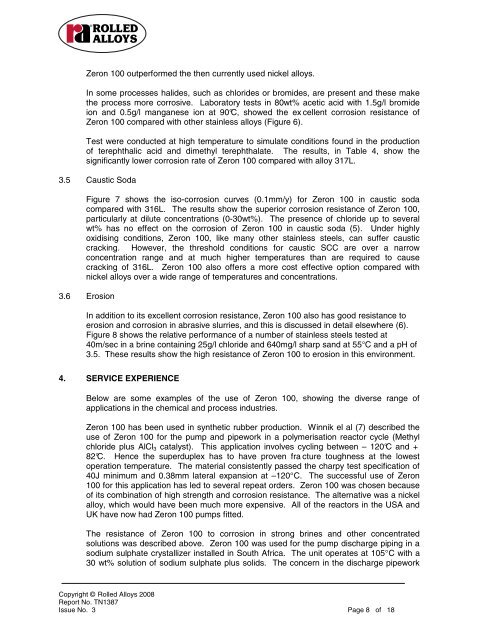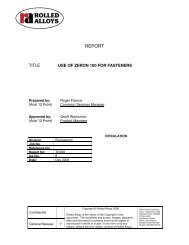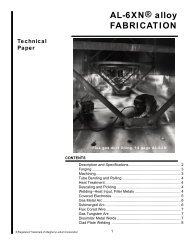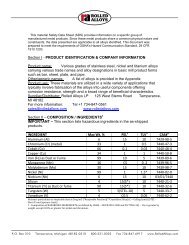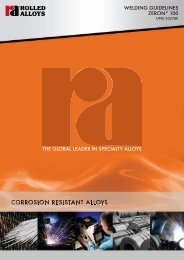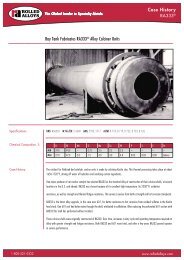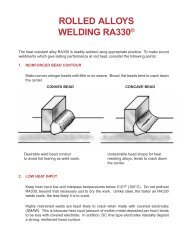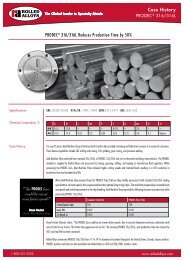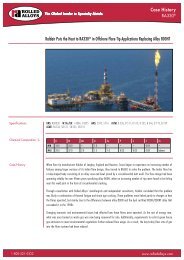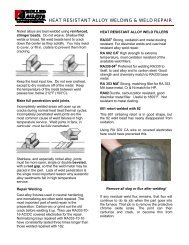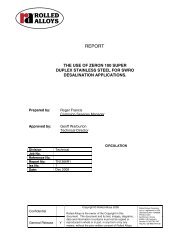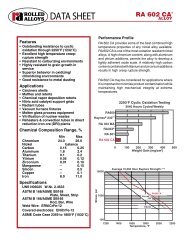ZERON 100 Chemical and Process Industries - Rolled Alloys
ZERON 100 Chemical and Process Industries - Rolled Alloys
ZERON 100 Chemical and Process Industries - Rolled Alloys
- No tags were found...
Create successful ePaper yourself
Turn your PDF publications into a flip-book with our unique Google optimized e-Paper software.
Zeron <strong>100</strong> outperformed the then currently used nickel alloys.In some processes halides, such as chlorides or bromides, are present <strong>and</strong> these makethe process more corrosive. Laboratory tests in 80wt% acetic acid with 1.5g/l bromideion <strong>and</strong> 0.5g/l manganese ion at 90°C, showed the ex cellent corrosion resistance ofZeron <strong>100</strong> compared with other stainless alloys (Figure 6).Test were conducted at high temperature to simulate conditions found in the productionof terephthalic acid <strong>and</strong> dimethyl terephthalate. The results, in Table 4, show thesignificantly lower corrosion rate of Zeron <strong>100</strong> compared with alloy 317L.3.5 Caustic SodaFigure 7 shows the iso-corrosion curves (0.1mm/y) for Zeron <strong>100</strong> in caustic sodacompared with 316L. The results show the superior corrosion resistance of Zeron <strong>100</strong>,particularly at dilute concentrations (0-30wt%). The presence of chloride up to severalwt% has no effect on the corrosion of Zeron <strong>100</strong> in caustic soda (5). Under highlyoxidising conditions, Zeron <strong>100</strong>, like many other stainless steels, can suffer causticcracking. However, the threshold conditions for caustic SCC are over a narrowconcentration range <strong>and</strong> at much higher temperatures than are required to causecracking of 316L. Zeron <strong>100</strong> also offers a more cost effective option compared withnickel alloys over a wide range of temperatures <strong>and</strong> concentrations.3.6 ErosionIn addition to its excellent corrosion resistance, Zeron <strong>100</strong> also has good resistance toerosion <strong>and</strong> corrosion in abrasive slurries, <strong>and</strong> this is discussed in detail elsewhere (6).Figure 8 shows the relative performance of a number of stainless steels tested at40m/sec in a brine containing 25g/l chloride <strong>and</strong> 640mg/l sharp s<strong>and</strong> at 55° C <strong>and</strong> a pH of3.5. These results show the high resistance of Zeron <strong>100</strong> to erosion in this environment.4. SERVICE EXPERIENCEBelow are some examples of the use of Zeron <strong>100</strong>, showing the diverse range ofapplications in the chemical <strong>and</strong> process industries.Zeron <strong>100</strong> has been used in synthetic rubber production. Winnik el al (7) described theuse of Zeron <strong>100</strong> for the pump <strong>and</strong> pipework in a polymerisation reactor cycle (Methylchloride plus AlCl 3 catalyst). This application involves cycling between – 120°C <strong>and</strong> +82°C. Hence the superduplex has to have proven fra cture toughness at the lowestoperation temperature. The material consistently passed the charpy test specification of40J minimum <strong>and</strong> 0.38mm lateral expansion at –120° C. The successful use of Zeron<strong>100</strong> for this application has led to several repeat orders. Zeron <strong>100</strong> was chosen becauseof its combination of high strength <strong>and</strong> corrosion resistance. The alternative was a nickelalloy, which would have been much more expensive. All of the reactors in the USA <strong>and</strong>UK have now had Zeron <strong>100</strong> pumps fitted.The resistance of Zeron <strong>100</strong> to corrosion in strong brines <strong>and</strong> other concentratedsolutions was described above. Zeron <strong>100</strong> was used for the pump discharge piping in asodium sulphate crystallizer installed in South Africa. The unit operates at 105° C with a30 wt% solution of sodium sulphate plus solids. The concern in the discharge pipeworkCopyright © <strong>Rolled</strong> <strong>Alloys</strong> 2008Report No. TN1387Issue No. 3 Page 8 of 18


